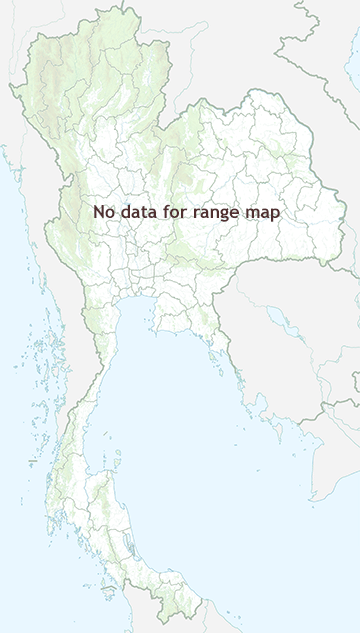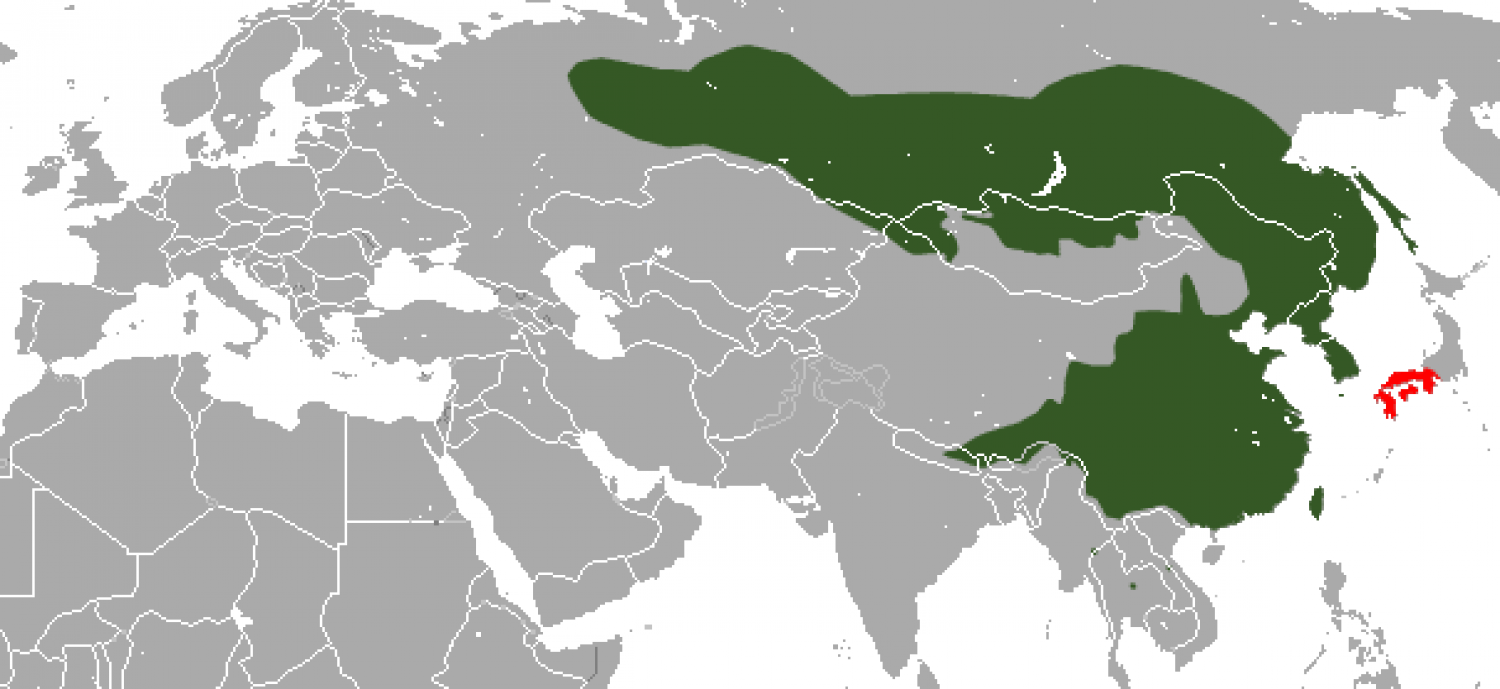Species of Thailand
Siberian weasel
Mustela sibirica
Peter Simon Pallas, 1773
The Siberian weasel (Mustela sibirica), also known as the kolonok or kolinsky, is a medium-sized species of weasel native to Asia. It is classed as Least Concern for extinction by the IUCN, due to its wide distribution and presumably large numbers.
In form and hunting behaviour, the Siberian weasel represents a transitional form between small mustelids (such as stoats and least weasels) and their larger cousins (minks and s). It is a valuable furbearer, particularly for the paint brush industry.
Description
Siberian weasels have long, stretched out bodies with relatively short legs, but are more heavily built than solongois, stoats and least weasels. Their heads are elongated, narrow and relatively small, and their ears are broad at the base, but short. Their tails represent half their body length. Siberian weasels are much larger than stoats and solongois, and almost approach ferrets and minks in size. Adult males are 28–39 cm long, while females reach 25-30.5 cm. The tail in males reaches 15.5–21 cm in length, while that of females reaches 13.3-16.4 cm. Males weigh 650-820 g, while females weigh 360-430 g. Exceptionally large individuals have on rare occasions occurred in the Baraba steppe. The skull is in several respects intermediate in form between that of the stoat and the mink ; it is longer and larger than that of the stoat, but is somewhat more flattened than the mink's.
Their winter fur is very dense, soft and fluffy, with guard hairs reaching 3–4 cm in length. The underfur is dense and loose fitting. Siberian weasels are monotone in colour, being bright reddish-ocherous or straw-red, though orange or peach tones are sometimes noticeable on the skin. These tones are especially bright on the back, while the flanks and underbelly are paler. A dark, coffee-brown mask is present on the face. Their tails are more brightly coloured than the back, and are fluffier than those of other members of the genus. The lips and chin are white or slightly ochreous. The front of the muzzle is darker than the remaining parts of the head.
Reproduction
Siberian weasels have an extended rutting period which is subject to geographic variation. The rut begins in early February through to late March in western Siberia. In Primorye, the rut begins in early March through to late April. Six pairs of Siberian weasels in a fur sovkhoz near Moscow began rutting from 25 April to 15 May. They mate for 35 minutes, doing so repeatedly. The gestation period lasts 38–41 days. There is one record of a female giving birth after only 28 days. Litters consist of 4-10 kits.
Kits are born blind and sparsely furred with white wool. They develop light yellow wool after a few days, and open their eyes after a month. Lactation stops after two months, and the kits stop growing and become independent by late August. By this time, the young are distinguished from the adults solely by their darker coats, deciduous tooth formula and lighter bones.
Burrowing behaviours
Siberian weasels are not fussy about their shelters. They may nest inside fallen logs, empty stumps, brushwood piles and exposed tree roots. They also use and enlarge the dens of other animals. The length of their burrows range from 0.6-4.2 metres and are 0.2-1.3 metres deep. The nesting chamber, which is located in the middle or end of the passage, is lined with bird feathers and rodent wool. Beside a permanent burrow, adults have up to five temporary shelters which are separated from each other by several kilometres.
Diet
In terms of prey selection, Siberian weasels are midway between small, rodent-eating mustelids and the more polyphagous martens. They rarely eat reptiles, invertebrates and plants, preferring instead to prey on rodents of small to moderate size. Water voles are their most frequent prey in their western range, while voles and mice are eaten in their eastern range. Moderate sized rodents targeted by Siberian weasels in the east include Daurian and Alpine pikas, and Siberian zokors. In local areas, chipmunks, muskrats, red squirrels and jerboas are eaten. Fish may be eaten in some areas during certain seasons. In Ussuriland, they may scavenge extensively on the kills of wolves and yellow-throated martens during the winter. Elsewhere, small birds are an important food item. Reptiles and amphibians are typically eaten at the periphery of the Siberian weasel's range. Plant foods known to be eaten by Siberian weasels include pine nuts and actinidia fruits. They typically eat about 100-120 gm of food daily, and cache excess food. In urban areas in China, Siberian weasels prey extensively on rats. They are capable of single-handedly killing and dragging the largest fowls. In contrast to sables, which are ambush predators, Siberian weasels are active hunters, readily chasing prey through snow, logs, water and people's houses.
Subspecies
, eleven subspecies are recognised.
| Subspecies | Trinomial authority | Description | Range | Synonyms |
|---|---|---|---|---|
| Siberian kolonok, Mustela sibirica sibirica | Pallas, 1773 | A small subspecies with light, yellowish-red fur. Skull length in males is 5.8-6.3 cm, while in females it is 4.9-5.6 cm | All of Siberia eastward to the Zeya River basin, contiguous parts of Mongolia and possibly extreme western parts of northeastern China |
australis (Satunin, 1911), miles (Barrett-Hamilton, 1904), |
| Tibetan kolonok, Mustela sibirica canigula | Hodgson, 1842 | Distinguished from other subspecies by having a much greater amount of white fur around the muzzle, neck and almost to the forelimbs. It has an exceptionally thick coat and bushy tail. The body is bright foxy-red, and lacks a black tail-tip | Tibet | |
| Manchurian kolonok, Mustela sibirica charbinensis | Lowkashkin, 1935 | Manchuria | ||
| Korean kolonok, Mustela sibirica coreanus | Domaniewski, 1926 | Korean Peninsula | peninsulae (Kishida, 1931) | |
| Taiwanese kolonok, Mustela sibirica davidiana | Milne-Edward's, 1871 |
Has a more intense colouration than fontanierii, being almost ochreous orange in fresh winter pelage |
Southeast China north to Hubei, Taiwan |
melli (Matschie, 1922), noctis (Barrett-Hamilton, 1904), taivana (Thomas, 1913) |
| North Chinese kolonok, Mustela sibirica fontanierii | Milne-Edwards, 1871 | Has a uniform pale fulvous coat with a pale brown forehead and muzzle, with varying degrees of white in the center of the throat and neck | Northern China, including Beijing, Hebei, Shandong, Shaanxi and Shanxi | stegmanni (Matschie, 1907) |
| Hodgson's kolonok, Mustela sibirica hodgsoni | Gray, 1843 | Distinguished from canigula by the smaller amount of white on the muzzle, the head's darker hue and the white area of the throat being limited to white patches rather than forming a continuous line. It is similar in size to subhemachalana and moupinensis, though its skull is smaller than the latter's | Kashmir and western Himalayas from Kam to Garwal | |
| Far Eastern kolonok, Mustela sibirica manchurica | Brass, 1911 | A somewhat larger subspecies than sibirica, with a lighter red coloured coat. Skull length in males is 6.3-6.7 cm, while in females it is 5.7-.6.2 cm | Priamurye to the west of the Zeya, Primorye and northeastern China | |
| Burmese kolonok, Mustela sibirica moupinensis | Milne-Edwards, 1974 | Closely resembles subhemachalana in having a black tail-tip, but distinguished by its larger skull and greater incidence of white fur on the muzzle | Sichuan, Gansu, Yunnan and Burma |
hamptoni (Thomas, 1921), major (Hilzheimer, 1910), tafeli (Hilzheimer, 1910) |
| Quelpart kolonok, Mustela sibirica quelpartis | Thomas, 1908 | Quelpart Island | ||
| Himalayan kolonok, Mustela sibirica subhemachalana | Hodgson, 1837 | Smaller than sibirica and has a blackish tail-tip. It lacks the typical white patch on the sides of the muzzle, which is blackish, save for narrow white lines on the edge of the upper lip and a white chin. The general colour ranges from bright foxy-red to dark chocolate brown | Himalayas from Nepal to Bhutan |
horsfieldii (Gray, 1843), humeralis (Blyth, 1842), |
Range
The range of the Siberian weasels includes northern Myanmar, Laos, North Korea, Pakistan, Nepal, India, (Himalayas), Bhutan, Russia (from the Kirov Province, Tataria, and the western Urals through Siberia and the Russian Far East), Taiwan and northern Thailand. They have been introduced to Honshu, Shikoku, Kamishima and Jebu.
Relationships with humans
In Chinese folklore, the Siberian weasel is viewed as a wandering spirit (shen) that can steal and replace people's souls.
Although Siberian weasels are overall useful for limiting rodent populations, they are nonetheless damaging to poultry and muskrat farms. They frequently enter the roosts of domesticated fowl and pigeons, sometimes killing more than they can eat.
Siberian weasels are valuable furbearers, being significantly harvested in Siberia and the Far East. Their fur is used both in its natural state and for imitating the fur of more valuable species. A couple of alternative names for the fur were Tartar sable and fire marten. Siberian weasel fur makes the finest water colour or oil paint brushes and is especially sought after by artists. The so-called kolinsky sable-hair brush is produced using the winter fur of the male Siberian weasel, not sable. In China, their orange fur is largely used to create ink brush for calligraphers. The name of the brush is thus 狼毫筆, lit. 'Wolf hairs brush', as a reduction from 黃鼠狼 + 毫 + 筆, lit. "yellow rat wolf" "hairs" "brush". Their hairs are appreciated because they are harder than goat hair (羊毫). They are hunted by shooting with dogs or through the use of box traps. They are extremely aggressive when caught in traps, emitting piercing shrieks and letting loose a pungent secretion which reportedly takes a month to wash away.
This article uses material from Wikipedia released under the Creative Commons Attribution-Share-Alike Licence 3.0. Eventual photos shown in this page may or may not be from Wikipedia, please see the license details for photos in photo by-lines.
Scientific classification
- Kingdom
- Animalia
- Phylum
- Chordata
- Class
- Mammalia
- Order
- Carnivora
- Family
- Mustelidae
- Genus
- Mustela
- Species
- Mustela sibirica
Common names
- German:
- Feuerwiesel
- Siberische wezel
- English: Siberian weasel
- Spanish: Comadreja siberiana
- French: Vison de Sibérie
- Italian: Donnola siberiana
- Russian:
- Колоно́к
- сиби́рский колоно́к
- Swedish: Sibirisk eldmård
Conservation status

Least Concern (IUCN3.1)
Photos
Please help us review our species pages if wrong photos are used or any other details in the page is wrong. We can be reached via our contact us page.
Range Map

